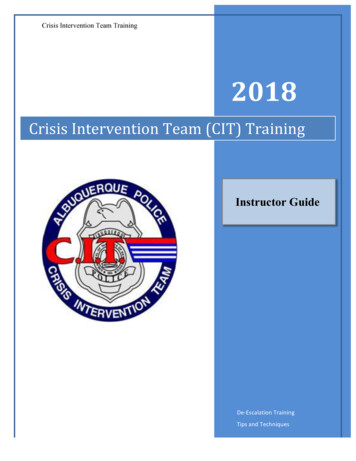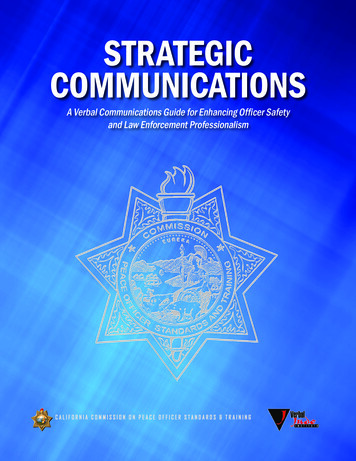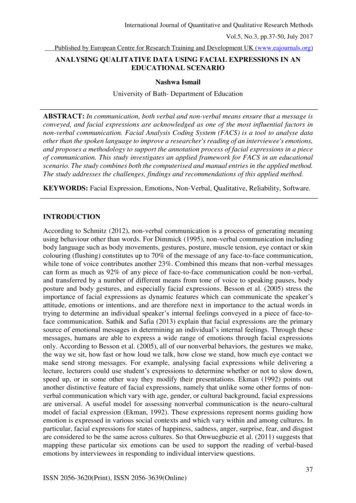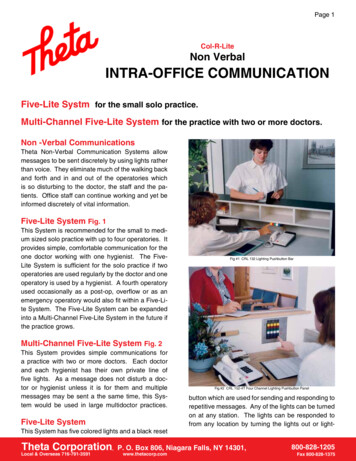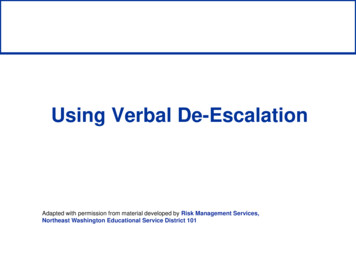
Transcription
Using Verbal De-EscalationAdapted with permission from material developed by Risk Management Services,Northeast Washington Educational Service District 101
How do you know when you are beingpersonally or physically threatened? You will know it when it happens to you. You will “feel” it. Trust your instincts
What is Verbal De-escalation? Verbal De-escalation is what we useduring a potentially dangerous, orthreatening, situation in an attempt toprevent a person from causing harmto us, themselves or others.Without specialized training, weshould never consider the use ofphysical force.Verbal De-escalation consists oftactics to help limit the number ofstaff who might be injured on the job.
Physical Force Use of physical force is NEVER recommended.Physical force would only beused as a last resort toprevent injury to yourself orto another person.Use of physical force usuallyresults in someone (you?)getting hurt.
This information WILL teach you: Verbal De-escalation tactics that are non-physicalskills used to prevent a potentially dangeroussituation from escalating into a physicalconfrontation or injury.
Verbal De-escalation Tactics Some Tactics are: Simply listening Distracting the other person Re-focusing the other person on something positive Changing the subject Use humor (sparingly) to lighten the mood (be verycareful with this!) Motivating the other person Empathizing with the other person Giving choices Setting limits
De-escalating Effectively To verbally de-escalate another person, you must open as many clear lines of communication as possible.Both you and the other person must listen to each other and have nobarriers.Barriers to Communication are the things that keep the meaning ofwhat is being said from being heard.Communication Barriers: Pre-judging Not Listening Criticizing Name-Calling Engaging in Power Struggles Ordering Threatening Minimizing Arguing
De-escalating Positively Use positive and helpful statements such as: “I want to help you!” “Please tell me more so I better understand how to helpyou.” “Let’s call Mr. Smith I know he would be able to helpwith this ” “Ms. Jones handles this for our district, let’s ask her whatshe thinks about this situation She is always willing tohelp!” Put yourself on his/her side of finding a solution tothe problem.
Listening Three Main Listening Skills: Attending: Giving your physical (and mental) attention to another person.Following: Making sure you are engaged by using eyecontact. Use un-intrusive gestures (such as nodding ofyour head, saying okay or asking an infrequentquestion.)Reflecting: Paraphrasing and reflecting, using thefeelings of the other person. (empathy) Listen when you are “listening.” No other activities when listening. Multi-tasking is not good when you are listening.
Be an empathic listener Do NOT be judgmental.Do NOT ignore the person or pretend to be paying attention.Listen to what the person is really saying.Re-state the message.Clarify the message.Repeat the message.Be empathetic!Validate -- “I understand why ” (Not in agreement with )Try to establish rapport with the other person.
Intro to Body Language 80% -- 90% of our communication is non-verbal. It is very important to beable to identify exactly what we arecommunicating to others nonverbally.You may be trying to de-escalate thesituation by talking to the otherperson, but your body language maybe showing a willingness to getphysical.It is also important that we recognizeand understand the non-verbal cuesfrom another person who has thepotential of escalating.
Body Language When people are angry, they sometimes do not“listen” to the words that are being said.Remember the difference between “hearing” and“listening.”Often, they do “see” and react to what you are“saying” with your body language.You must always be very careful with the messageyou are sending!
Body Language Finger pointing may seem accusing or threatening.Shoulder shrugging may seem uncaring orunknowing.Rigid walking may seem unyielding or challenging.Jaw set with clenched teeth shows you are not openminded to listening to his/her side of the story.A natural smile is good. A fake smile can aggravatethe situation.Use slow and deliberate movements -- quick actionsmay surprise or scare the other person.
Body Language -- Eyes One eyebrow raised “sternness”Eyes open wide “surprise”A hard stare “threatening gesture”Closing eyes longer than normal “I’m notlistening” and/or “Change your message!”(This may be a warning that you areunintentionally escalating the situation!)
Personal Space Invasion or encroachment of personal space tends toheighten or escalate anxiety.Note: Personal space is usually 1.5 to 3 feet-- far enough away so you cannot be hit or kicked.Do not touch a hostile person -- they might interpretthat as an aggressive action.Keep your hands visible at all times -- you do notwant the other person to misinterpret your physicalactions.
Challenging Posture Challenging postures thattend to threaten anotherperson and escalate anysituation include: Face to face Nose to nose Toe to toe Eyeball to eyeball Touching Finger pointing
Protect yourself at all times While de-escalating another person,you want to be in a non-threatening,non-challenging and self-protectingposition.Slightly more than a leg’s length away,on an angle and off to the side of theother person.Stay far enough away that the otherperson cannot hit, kick or grab you.
Use of your voice ToneVolumeRate of speechInflection of voice
Tone of your voice A lowered voice level may set a tone of anger which could create fear or challenges.A raised voice may set a tone of anticipation or uncertaintywhich may promote excitement or disruption.Speak slowly -- This is usually interpreted as soothing.A controlled voice is one of calm and firmness which promotesconfidence in both parties.Humor may unintentionally offend someone and escalate thesituation. -- Use humor sparingly and always direct humortoward yourself. (Be very careful when attempting humor inthis type of situation!)Always be respectful to the other person.Using “please” and “thank-you” -- “Mr” or “Ms” indicatesrespect.
“Inflection of voice” examples:What do these words mean?“I didn’t say you were stupid.” I didn’t say you were stupid.(Your brother said it!) I didn’t say you were stupid.(But I did write it on the bulletin board!) I didn’t say you were stupid.(I said your brother was stupid) I didn’t say you were stupid.(I said you were a complete idiot.)
Tips Remain calm -- Listen - really listen! Avoid overreaction. Validate! “I understand why you might be upset.” (This does not indicate that you agree with them.)Remove onlookers -- or relocate to a safer place. (Onlookers canbecome either “cheerleaders” or additional victims.) Send anonlooker for help.Watch for non-verbal clues or threats.Bring in another trained person to assist whenever possible.There is less chance of aggressive behavior if two people aretalking to one person.
Ask for Help! Alert someone else as soon aspossible. (No help will arrive untilsomeone else knows your situation.Until then, you are all alone.)Two heads are always better than one.There is safety in numbers.It will be beneficial to have a witness, ifthe situation deteriorates andsomeone is injured.
Notification and Follow-up Always report minor situations.Minor situations can be a “cry for help” and/or“warning signs” of bigger things to come!Minor situations can lead to major situations.After any confrontation, advise or direct theperson to counseling, if possible.Always document every threatening event.Documentation will help all parties whenevaluating re-occurring events.
Things NOT to do! Avoid becoming emotionally involved -- control your emotions at all times.Avoid engaging in power struggles.Avoid becoming rigid in your process.Avoid telling the other person that you “know howhe or she feels.”Avoid raising your voice, cussing, making threats,and giving ultimatums or demands.Avoid aggressive language, including bodylanguage.Do not attempt to intimidate a hostile person.
Not the End After your personal safety is secured, there areseveral other steps that must be taken: Intervention must occur to end the situation, if that has not yet occurred. This may be accomplished by supervisors,security or police, depending on the circumstances. Makesure your appropriate chain of command has all of the facts.You should receive medical treatment for any physicalinjuries.Counseling for post-traumatic stress and fear resulting fromthe incident may be appropriate.KEAP can conduct a de-briefing session with involved staff.Look at steps to be taken to prevent other similar situationsfrom occurring in the future.
non-verbal. It is very important to be able to identify exactly what we are communicating to others non-verbally. You may be trying to de-escalate the situation by talking to the other person, but your body language may be showing a willingness to get physical. It is also important that we reco
